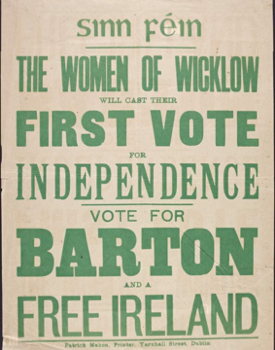Collections: Bartons of Glendalough Estate






The Barton family descend from Thomas Barton, a Protestant soldier from Lancashire who came to Ireland with the Earl of Essex’s army in 1599. Ten years later, Thomas was awarded an estate of 1000 acres in County Fermanagh for his services to the Crown. His son Anthony was one of untold thousands of Protestant settlers murdered during a savage uprising by Ulster Catholics in October 1641. During the reign of Charles II, her son William recouped the family fortunes and became a substantial landowner in Fermanagh and Donegal. In 1725, William’s grandson Tom Barton settled in Bordeaux and established himself as a wine merchant. The business boomed over the ensuing decades. Tom’s only son married Grace Massy, a daughter of the Dean of Limerick, and sister of Sir Hugh Dillon Massy of Doonas, Co. Clare. William and Grace’s fourth son, Hugh succeeded to the family’s wine estates on the death of his grandfather in 1780.
In I794, during the reign of terror at Bordeaux, a large number of the leading merchants were thrown into prison and their offices closed. Among those arrested was Hugh Barton, who was confined in the prison of the Fort du Ha, from which, through the connivance of his wife Anne (naturalized daughter of Nathaniel Weld Johnson, himself a naturalized French subject of Scotch origin), he made his escape to Ireland. A very interesting story is told of the way in which his French property was preserved. Not being allowed as an alien to hold property in Bordeaux, he arranged with one Daniel Guestier to take over and manage the business there, while Hugh Barton would manage it in Great Britain. This was done without any act of partnership.
Bartons of Straffan
In 1831 Hugh Barton purchased the estate of Straffan in County Kildare. His son, Thomas Johnston Barton settled in Glendalough, County Wicklow. The Straffan estate remained with the Barton family until 1949 when Derick Barton sold the house to John Ellis of Yorkshire.
Thomas Johnston Barton
Hugh and Anna’s third son, Thomas Johnston Barton, was born in September 1802. On 25th March 1830 Thomas married Frances, a granddaughter of Thomas, Ist Lord Erskine, the eloquent Scots barrister who famously defended Thomas Paine’s ‘Rights of Man’ in 1792 (his great-great-grandson was Erskine Childers).
The Hugo family and Glendalough Estate
In the late 1830s, Thomas and Frances Barton purchased the Glendalough (or Drummin, Dromeen) estate at Annamoe, County Wicklow. Situated between Djouce Mountain and close to the waters of Lough Dan, the estate previously belonged to the Hugos, an English Protestant family from the mid-1700s. Thomas and Frances raised four sons and four daughters in Glendalough. Thomas served as Justice of the Peace and Deputy Lieutenant for County Wicklow. He died on 4th September 1864.
Charles Barton and Charles Parnell
Thomas Barton’s second son, Charles William Barton, was born on13th July 1836. As a young man he was friendly with his neighbour, Charles Stewart Parnell, sharing a passion for cricket and sawmills! However Charles became a committed Unionist and fell out with Parnell. Charles succeeded to Glendalough in 1874. He married Agnes Alexandra Childers. Charles’ sister, Anna – Erskine’s mother- married Professor Robert Caesar Childers. This is how the destiny of the Barton and Childers families became entwined. Anna and Professor Childers died of tuberculosis. Erskine Childers and his orphaned siblings were sent to Glendalough to live with their aunt and uncle in 1883.
Robert Barton – Anglo-Irish Rebel
The eldest of the Barton boys, Robert, was educated in Christchurch College, Oxford and at the Royal Agricultural College in Cirencester. By the time of his road trip with Erskine in 1908, he was seen as a progressive landlord. He was elected Sinn Fein MP for West Wicklow in 1918. He was simultaneously appointed Chairman of Wicklow County Council. In February 1919 he was arrested for making seditious speeches and imprisoned at Mountjoy Prison. Collins helped him escape on 16th March (Robert left a note to the Governor explaining that he could no longer stay as the service was dissatisfactory. Moreover, he wondered, would they mind looking after his luggage until he sent for it?). He was rearrested in1920 and sentenced to three years in England’s Portland Gaol. Barton was released on the signing of the Truce in 1921.
Later career
After Erskine’s execution in 1922, Robert Barton continued to support Eamon de Valera. He was elected to the Dáil in June 1922 but did not take his seat or seek re-election later. Robert Barton was also Chairman of the Agricultural Credit Corporation from 1934 to 1954 and Director and Chairman of Bord na Mona for many years. In the Summer of 1950, the 69 year-old finally took wife – Rachel Lothrop Warren, the daughter of Fiske Warren. Robert Barton died peacefully in Glendalough on 8 August 1975, aged 95. Shortly before the end of his life, Robert Barton told Roy Foster about an early memory of his nurse lifting him up to a window to see the enigmatic red-bearded patriot arriving at Glendalough House on his horse to inspect a fallen tree in the wake of the great storm in 1888: ‘The inspiration of that glimpse from the window remained. It is in its way a Carlylean moment: a sudden conjunction of the personal and the ‘world-historical’. But it also puts back in focus the world of Parnell and his neighbours, the symbiotic way in which his life reacted upon theirs and theirs upon his’.
Notes:
Further information:
The National Inventory of Architectural Heritage: Glendalough House
Michael Fewer, “R.C. Barton and Glendalough House” in Roundwood & District Historical & Folklore Journal No.19 (2008).
Descriptive list of Barton collection attached below:




No Comments
Add a comment about this page